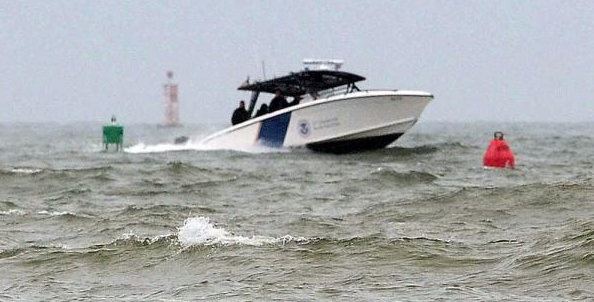
A U.S. Customs and Border Protection vessel, participating in their St. Augustine training program, powers through the inlet, between channel markers and with the sea buoy in the background. Photo by Peter Willott, courtesy of the St. Augustine Record.
In last Sunday’s local newspaper there was a great article on St. Augustine’s Inlet. Our port’s connection to the sea has always been a vital but potentially dangerous link to the outside world, and the hazards of navigating the channel are still well-known to mariners today, as they were for hundreds of years.
From the St. Augustine Record:
With constantly shifting sands, the St. Augustine Inlet has always been a challenge to navigate, and vessels have foundered trying to enter the nation’s oldest port since the earliest days of colonization. Even the United States Coast Guard (USCG) Notice to Mariners lists the St. Augustine Inlet as “dangerous due to shifting shoaling.”
LAMP’s own Brendan Burke, a licensed boat captain, was consulted for the article and his quotes are prominently featured:
But Brendan Burke, an archaeologist with St. Augustine’s Lighthouse Archaeological Maritime Program (LAMP) and a licensed boat captain, said the bad rap is undeserved.
“Our inlet is a constantly changing channel,” Burke said. “That has been the consistent theme to our inlet for the past 447 years. It is really no worse than many other inlets on the East Coast. While it is unfortunate that some cruisers may avoid St. Augustine for this, the reality is that our channel’s constantly shifting nature requires constant vigilance and re-marking to maintain it as a safe passage.”
Because of that constant change, the National Oceanic and Atmospheric Administration (NOAA) does not even include data about depths or course plotting for the St. Augustine Inlet on its charts.
Burke said it’s important for anybody using the inlet to use knowledge, caution and common sense.
“Either conditions favor going in or out or they don’t,” he said. “Either a helmsman has local knowledge or he doesn’t. Either you navigate prudently or you don’t. Any one of these ‘don’ts’ can equal loss of property or life and an inlet is a tough place to find out your maintenance or seamanship is lacking.”
Burke said the shoaling of the inlet is unavoidable, despite the best efforts of man.
“The straight channel that once existed was a complete anomaly in nature,” Burke said. “That channel did not pay attention to the fact that the shoal also wishes to reside in the same space. Therefore, the inlet channel strays from its intended location. Man created (the straight channel) and nature put it back the way it wants.”
The last time the inlet was fully dredged was in 1999, Rippe said. The maintenance of the channel and inlet for navigation is the responsibility of the U.S. Army Corps of Engineers.
Emergency dredging was performed at the mount of the inlet in August 2011 with 4,500 cubic yards of sand removed over a 2-day period. Then, in September of this year, a $21 million project funded by the U.S. Army Corps of Engineers and St. Johns County dredged 1.2 million cubic yards from the inlet as part of the St. Augustine Beach renourishment effort.
Read the whole article here.
The article also has a sidebar that can be seen here. It focuses on the great numbers of shipwrecks that have taken place at the mouth of the inlet over the centuries, many of which have been the subject of LAMP research:
Many ships have sunk in the waters off St. Augustine in the past 450 years. One of the earliest documented was the Nuestra Senora de las Olas, which was lost on the “bar” just outside the inlet while leaving St. Augustine in 1595.
“A bar is a uniquely shallow point on the ebb delta over which a channel passes, and all inlets have one,” said Brendan Burke, an archaeologist with St. Augustine’s Lighthouse Archaeological Maritime Program (LAMP). “At this point, wave intensity is magnified by the shoaling and frequently causes not only dangerous waves, but very shallow water.”
St. Augustine has been no exception, Burke said, and there have been “many manifestations of different inlets here caused by nature and man.”
“Sailing ships over St. Augustine’s historic inlets were known to ‘scud’ over the bar, sometimes touching their keels on the hard packed sand,” Burke said. “Nuestra Senora de las Olas sailed into St. Augustine sometime during 1593 for repairs, and though she made it into port, she was lost on the bar when attempting to leave.”
LAMP has an animation that shows the evolution of St. Augustine’s inlets over the centuries at www.staugustinelighthouse.org/ourstories/LighthouseStory.
For more on the lost ships off St. Augustine, check out www.staugustinelighthouse.com/lamp/research/lostships.

